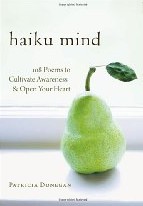Haiku Exercise 2: brief 3-line nature poem with two juxtaposed images and '5-7-5' syllables
Haiku exercises from a Poetry Seminar
given at UCSC November 2009 by J. Zimmerman
Goal of this set of exercises:
- Write at least THREE haiku-like poems through three exercises:
- Learn and apply THREE core attributes of a "classical" haiku.
- Explore history of linked verse and the rise of haiku and senryu.
- Share resources: books, journals, web sites, places to submit work.
Exercise 2:
brief 3-line nature poem
with two juxtaposed images and '5-7-5' syllable
Your second poem will use the THREE core attributes of a "classical" haiku):
- A "kigo" (season word(s)) of your choice: let's limit it to an autumn "kigo".
- Juxtaposed nature images.
- '5-7-5' syllables.
In Haiku Exercise 1,
you were given the kigo image.
Here, let's begin by developing your own kigo image:
- Pick an autumn kigo. Some possibilities are:
- falling leaves
- moon
- scarecrow
- chestnuts
- migrating geese
- chrysanthemum
- persimmon
- Add word(s) to the kigo so you have 5 syllables for the first line.
For example:
- wind-torn walnut leaves
- a scarecrow's top hat
- Although '5-7-5 syllables' is roughly twice as long as the '5-7-5
morae'
formal pattern of classical haiku,
we use syllables in this exercise to get a sense of how this pattern feels.
Once you've established your kigo image with 5 syllables:
- Think of an emotion that comes up.
- Think of another nature image that makes you aware of that emotion.
- Write your new image in a couple of lines, using 7 and 5 syllables, to complete your 5-7-5 haiku.
- Simply juxtapose your two images (one image in one line and the other in two lines);
optionally separate the images by em-dash, ellipsis, etc.
Extra practice with syllables:
- Write various autumn images from nature in 5 syllables on small cards.
- Write various images from nature in 12 (7 plus 5) syllables on small cards.
- Mix each set of cards.
- Pick one card at random from each set.
Contemplate whether the two images work well together, or are too similar (the gap is too small),
or are too far apart (the gap is too large).
Extra practice with morae:
For extra and more challenging practice
do the same as the previous exercise with
morae.
To a good approximation:
- Count an English short vowel
(such as "i" and "e" in "little") as one
mora each.
- Count an English long vowel
(such as "oo" in "moon") as two
morae.
Thus, the extra practice with morae is:
- Write various images from nature in 5 morae on small cards.
- Write various images from nature in 12 (7 plus 5) morae on small cards.
- Mix each set of cards.
- Pick one card at random from each set.
Contemplate whether the two images work well together, or are too similar (the gap is too small),
or are too far apart (the gap is too large).
 [Thanks for visiting.]
[Thanks for visiting.]







